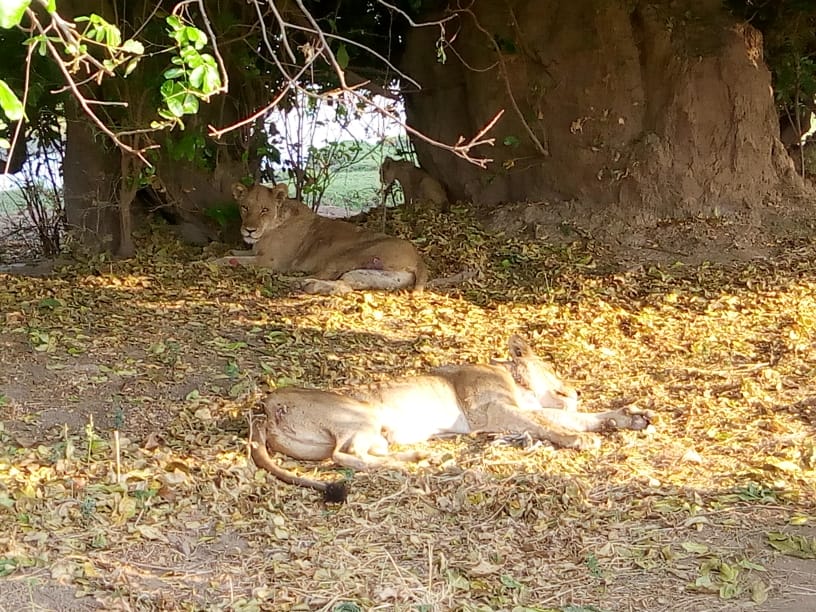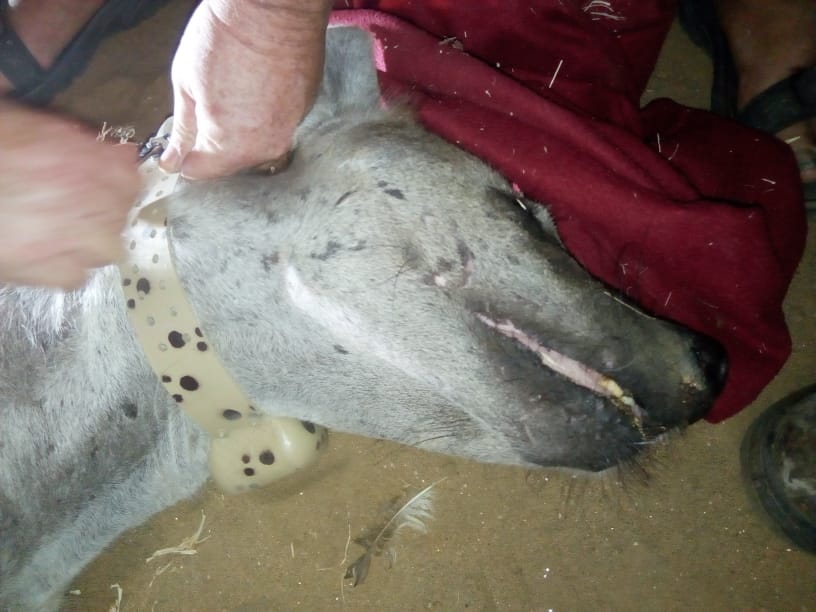The Zambezi Valley Conservation Network spoke to Principal Ecologist, Jeremiah Chakuya, to understand the objectives of the carnivore research project being undertaken by Zimbabwe Parks and Wildlife Management Authority (ZPWMA) in Mana Pools and the Middle Zambezi.

African lions and leopards are classified as vulnerable species on the IUCN Red List, with human settlement, agriculture and poisoning indicated as the main threats. (Mid Zambezi Scientific Services Unit)
Mana Pools National Park is home to several carnivores, including hyenas, lions and leopards, which are known for their predation on both wild and domestic animals. However, over the last few years, the impact of drought induced by climate change, changes in prey availability, competition and kleptoparasitism on carnivores has not been well researched in Mana Pools and the surrounding other protected areas in Middle-Zambezi.
Recognising the importance of the spatio-temporal movements of carnivores to maintain species population and balanced ecosystems, ZPWMA with funding and support from Bushlife Conservancy, and Bushlife Support Unit, launched a long-term research project in May 2021, to investigate the movements and interactions of lions, hyenas and leopards in Mana Pools National Park. Read more about the research work of Bushlife Conservancy.
The carnivore research, which primarily involves collaring to gather information, is being led by ZPWMA Principal Ecologist, Jeremiah Chakuya, who is currently stationed in Marongora Field Station and working across numerous research projects.
The study aims to guide ZPWMA on the development of valuable management practices of carnivores within a protected area, as well as develop sound Human Wildlife Conflict mitigation strategies. Findings from the study will contribute knowledge to the National Conservation Action Plans of the respective carnivore species.
Overview of Research Objectives
- Accurately count numbers of carnivores
- Determine the lions, leopards, and hyena home ranges
- Determine the spatial distribution of each group of predators and the spatio-temporal interaction of carnivores within the protected areas
- Determine the level of interspecies competition
- Investigate the extent of carnivores kleptoparasitism within Mana Pools National Park
- Gain an in depth understanding of the threats to carnivores in Mana Pools and the Middle Zambezi Valley
- Establish lions, leopards and hyena prey preferences
- Develop human wildlife Conflict (HWC) management strategies
- Track predator impact of wild dog populations

Competition among carnivores needs to be monitored and GPS collars are conventionally accepted as an ideal method to monitor carnivores’ interaction and home range use. (Mid Zambezi Scientific Services Unit)
Research methodology and implementation
The spatio-temporal research primarily entails the collaring of the carnivores. “GPS collars are conventionally accepted as an ideal method to monitor carnivores’ interaction and home range use,” says Chakuya, who along with the research team including Bushlife Conservancy, has successfully collared 17 animals since the start of the research programme.
In addition, monitoring carnivores using collars also enables investigations of major carnivores involved in Human Wildlife Conflicts, thus helping development of sound conflict mitigation measures.
Thus far, 17 collars have been deployed including eight collared lions, six hyenas and three leopards. The team aims to collar at least three more leopards.
Watch: Bushlife Conservancy video giving an overview of the ZPWMA research project activities and objectives: https://youtu.be/Ydn1_SuO0Rw.
Key observations and intended outcomes
Information regarding threats and their mitigation are generated and disseminated across Zimbabwe, thus helping development of management plans and strategies.
Threats to carnivores, globally and in the Middle Zambezi
Globally, lion and leopard populations are declining, with several lines of evidence suggesting that carnivore’s survival is being increasingly threatened by factors such as climate change, kleptoparasitism (theft of another animal’s food) and anthropogenic activities. African lions and leopards are classified as vulnerable species on the IUCN Red List of threatened species, with human intrusion and development, hunting and trapping, pollution, agriculture, livestock farming and poisoning indicated as some of the main threats.
“For decades, both legal and illegal persecution and retaliatory wildlife kills were the main threats to carnivores in Africa. In recent years, this organised killing of wildlife, including carnivores, has subsided and now instead there is a rise in other threats which are even more difficult to control, such as kleptoparasitism,” says Chakuya, who says the spatio-temporal movements of carnivores is critical to carnivore conservation.
In the Middle Zambezi Valley, climate change is becoming a significant threat, affecting both wildlife and humans. The wildlife-rich protected areas are experiencing recurring droughts which has led to reduced food on the Mana Pools floodplains for herbivores and grazers which were once abundant and thus a primary food source for the National Park’s carnivores. Kleptoparasitism by hyenas, especially to other carnivores like lions and leopards, is a cause of concern in terms of maintaining ecosystem balance, and this competition among carnivores needs to be monitored.
In 2020, many episodes of human wildlife conflict were reported, with leopards extending their territory into a local village outside of the border of Mana Pools National Park. Bushlife Conservancy and Support Unit worked diligently with ZPWMA to trap, collar and relocate these animals.
The adaptation and increased home ranges of such carnivores thus needs to be monitored in relation to prey availability to ensure balance within ecosystems. Predator and competitor avoidance among these carnivores play a pivotal role in structuring species communities. For example, a reduction in activity or an increase in use of refuge due to the perceived risk of predation can lead to a reduction of foraging rate. Spatio-temporal monitoring of carnivores is thus important as some species may evolve an ability to adapt avoidance and competition tactics.
With the support of Bushlife Conservancy, animals are being translocated from communal areas. However, they often seem to make their way back. This was the case with a problem leopard that walked 50 km over three days to return to its home range. However, it did not go back to stock killing but stayed in the wilderness area not crossing to the villages.
It has been observed that collared Lions in Mana Pools National Park do not move out of the Mana Pools National Park area and if they do this is usually at night and for short periods of time. Observations from continuous monitoring has revealed that collared hyenas most of the time follow the collared lions during the night, which is a great potential sign of kleptoparasitism within the ecosystem.
As per the Bushlife Conservancy website, “the knowledge and insights gained will benefit the short and long-term survivability of wildlife and preservation of the environment in the Lower Zambezi Valley. The local communities will be further supported through the financial resources and employment which this project will generate. “The scientific data collected from this project will allow national parks to come up with scientific strategic management plans for the species involved.”

